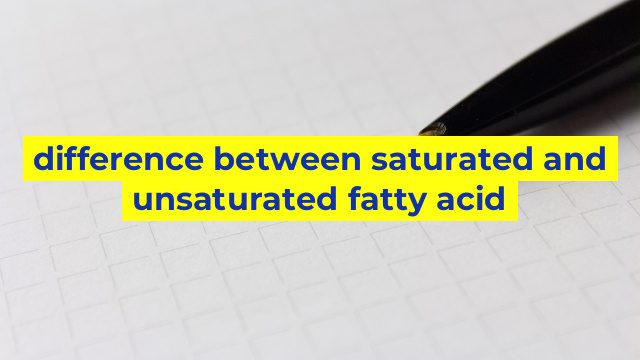The Difference Between Saturated and Unsaturated Fatty Acids
Introduction
Fatty acids are essential nutrients that our body needs to function properly. They are the building blocks of fats and oils and are categorized into two main categories: saturated and unsaturated. While both types of fatty acids are important for our body, there are some key differences between them that can affect our health. In this article, we will discuss the differences between saturated and unsaturated fatty acids.
Saturated Fatty Acids
Saturated fatty acids are found in animal products such as meat, dairy, and eggs, as well as in some plant oils such as coconut oil and palm oil. They are called “saturated” because their chemical structure is fully saturated with hydrogen atoms, meaning there are no double bonds between carbon atoms.
Because of their chemical structure, saturated fatty acids tend to be solid at room temperature. Consuming too much saturated fat has been linked to an increased risk of heart disease and high cholesterol levels. This is why health professionals often recommend limiting our intake of saturated fat.
Unsaturated Fatty Acids
Unsaturated fatty acids are found in plant-based oils such as olive oil, canola oil, and avocado oil, as well as in fatty fish like salmon and tuna. They are called “unsaturated” because they contain one or more double bonds between carbon atoms. This makes their chemical structure unsaturated with hydrogen atoms.
Because of their chemical structure, unsaturated fatty acids tend to be liquid at room temperature. Consuming foods high in unsaturated fat has been linked to several health benefits, including reducing the risk of heart disease and improving cholesterol levels.
The Bottom Line
In summary, the main difference between saturated and unsaturated fatty acids is their chemical structure. Saturated fatty acids are fully saturated with hydrogen atoms and are solid at room temperature, while unsaturated fatty acids contain one or more double bonds between carbon atoms and are liquid at room temperature.
While both types of fatty acids are important for our body, excessive consumption of saturated fatty acids can lead to health problems, whereas consuming foods high in unsaturated fatty acids can be beneficial for our health. By choosing foods high in unsaturated fat and limiting foods high in saturated fat, we can improve our overall health and reduce our risk of disease.
Table difference between saturated and unsaturated fatty acid
| Fatty Acid Type | Saturated | Unsaturated |
|---|---|---|
| Definition | Fatty acids that have no double bonds in their carbon chain | Fatty acids that have one or more double bonds in their carbon chain |
| Structure | Straight chain, tightly packed molecules | Bent, loosely packed molecules |
| State at Room Temperature | Solid | Liquid |
| Source | Animal products, coconut oil, palm oil | Nuts, seeds, fish, avocado, olive oil |
| Health Effects | Increase LDL (“bad”) cholesterol, increase risk of heart disease | Decrease LDL cholesterol, decrease risk of heart disease, provide essential fatty acids for the body |
